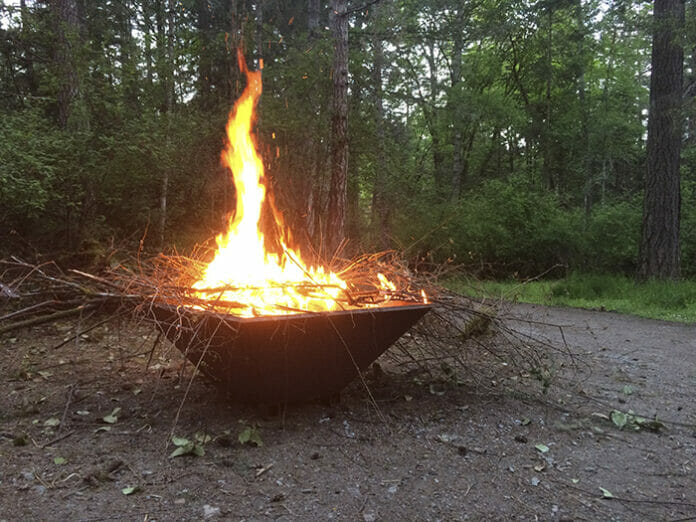It’s such an elegant solution — and to such relatable island problems — it’s hard to imagine it not catching on.
Over a coffee on a grey afternoon, and still chilled from a damp bicycle ride into town, Brian Smallshaw leans in as we discuss how to best frame a discussion about biochar on Salt Spring.
“It’s small-scale carbon sequestration,” he says.
“Boutique?” I suggest.
“Artisanal!” he laughs.
Understanding biochar isn’t difficult, thankfully — it’s just charcoal, incompletely burned wood produced in a low-oxygen environment. There is, of course, a rich history of charcoal here in the Gulf Islands; pit kilns have been found on nearly every island, and most in Ganges know of the two in Mouat Park built by Isaburo Tasaka in the early 1900s.
But the Biochar Working Group — led by Smallshaw, and part of Transition Salt Spring — is aiming for more than just producing cooking fuel. Smallshaw has been experimenting with special portable open-topped kilns, designed to turn our yard waste into charcoal— and solve a dilemma faced by thoughtful neighbours after every storm.
“You get all the branches and stuff that comes down in winter storms,” says Smallshaw. “And what do you do with it all?”
The usual solution, of piling it up and setting it ablaze, is a smoky endeavour that can irritate neighbours — and their lungs. Wood chippers are loud, burn fossil fuels and need a fair bit of maintenance. Those are fine measures for some situations, according to Smallshaw, but if all that feels a little wasteful, it’s because it is.
“From my point of view, as somebody who’s been using biochar, it’s a waste of resources,” he says. “You’ve got something that you could turn into a something useful for your garden, for your fruit trees, instead of burning it up and sending it all up the atmosphere.”
And there it is, the real rabbit in biochar’s hat: a carbon sequestration process you can touch and feel, and actually get on your fingers. Burning wood to ash sends practically all of its carbon potential into the air; letting it decompose on the ground over decades eventually produces the same result. But halt the process, and you keep a large fraction of that carbon in the biochar. It’s incredibly stable — more or less pure carbon — and tends to stay right where you put it.
Smallshaw, naturally, recommends putting it in your dirt.
“Biochar is charcoal, but for soil amendment purposes,” he says, “charcoal that you’re going to put into the ground to make your garden grow better, or around your fruit trees.”
It was European settlers in the Amazon basin who stumbled across how wonderful charcoal-amended soil was, Smallshaw says; in a region particularly known for poor crops, they found distinct “islands” of high fertility where their plants were flourishing.
“The Portuguese who were there referred to those areas of ‘dark soils,’ and for the longest time, they didn’t understand why these places existed, or why they were so good for cultivating crops,” he says. “Eventually they learned the Indigenous farmers had cleared an area, making a huge pit where they would pile up and burn organic material; days or weeks later they would put the fire out with dirt, and plant crops on top of it.”
The charcoal they created remained in that soil for centuries — like a permanent fertilizer, says Smallshaw. There are several reasons why it seems to work so well — biochar improves water retention, helping regulate moisture in areas that get big rains and long dry spells, and charcoal has millions of tiny crevices and cavities where beneficial microbes thrive.
Back on Salt Spring, Smallshaw’s kilns create a little ash alongside the biochar in their process — it’s unavoidable, you won’t get much charcoal out of leaves and tiny branches — but that seems helpful, too. In small amounts, ash has a proven track record in “sweetening” soil, changing the pH to make it less acidic.
But the charcoal is the thing. Smallshaw describes his kilns as having an optimal design for ease of use and yield working with post-storm yard debris. The inverted pyramid shape creates airflow from the top, creating very hot, very tall and quite narrow flames. The heat from the walls is kept off the ground, reducing the chance of igniting nearby roots, and reflects back into the fire to aid combustion and reduce smoke. As woody debris is added to the top, it gradually halts combustion of material on the bottom, and — done properly, Smallshaw hosts workshops — eventually leads to a kiln full of biochar.
The final party trick: Smallshaw’s kilns have a hose attachment. When the kiln is full, you turn on the water and flood the compartment from the bottom, completely putting out the fire.
There are more than 20 of these kilns in private hands across Salt Spring Island, according to Smallshaw, and the Biochar Working Group just received a Salt Spring Island Foundation grant to deploy three for public use — and that’s just a beginning, he says.
“What I’d like to do is have one in every neighbourhood,” says Smallshaw, “so people could borrow the neighbourhood kiln for a week, bring it home and make some biochar, then bring it back.”
A pilot program is looking for hosts. Smallshaw said anyone interested in “adopting” a kiln and helping administer the process of loaning it out should contact him via email at b@pixelmap.ca.


Great initiative.
http://www.computare.org/Support%20documents/Publications/Soil%20from%20Oil/Soil%20From%20Oil0001.pdf